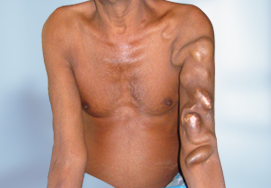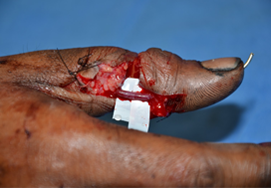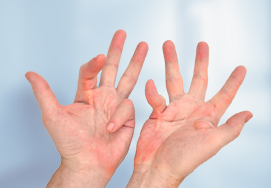Hand Fractures
Individuals who have displaced fractures, comminuted fractures, open fractures, and unstable fracture reduction

- What is a Hand Fracture?
- What are the symptoms of hand fracture?
- How is a hand fracture diagnosed?
- What are the types of the surgeries?
- Which individuals are eligible for hand fracture surgery?
- How should I prepare for the surgery?
- What will happen during the surgery?
- What is the aftercare of the surgery?
- How to return to the normal functions after treatment?
- What are the postsurgical considerations of the surgery?
- What can I do to help my hand heal?
What is a Hand Fracture?
Hands are capable of performing a wide variety of functions which include touching, grasping, feeling, holding, manipulating, caressing, and more. Trauma or injury to the hands leading to fractures is very common and is associated with loss of function which can impact almost all activities of daily living, and work productivity
Hands are made up of many bones which make up the fingers (phalanges), knuckles, and connect the knuckles to the wrist (metacarpals). Han fractures can have soft tissue injury with an associated bone injury. Proper management at initial evaluation of hand injuries can prevent a significant amount of morbidity, disability and improves functional outcome. Thereby helping to return to work and productivity
A fracture of bone may cause pain, loss of function, and stiffness. It may limit your ability to perform daily activities, and if left untreated, it can lead to long-term disability and deformity. Hand fractures can be either in small bones of the fingers (phalanges) or long bones (metacarpals). Fractures occur due to twisting, injury, a fall, a crush injury, or direct contacts in sports, and motor vehicle crashes.
Fracture surgery realigns and stabilizes the bone fragments. The surgery involves placing the wires, screws, or plates in the fractured bone to hold the fragments. It aims to improve appearance and function of your hand.
Plastic surgeons are capable of handling both closed and open fractures along with soft tissue injury and soft tissue loss as they are trained in handling both fractures an soft tissue injuries.
What are the symptoms of hand fracture?
- Severe pain at the fractures site
- Swelling, bruising or bleeding around the fracture site
- Deformity when Bone or joint that looks out of place or the wrong shape
- Weakness, numbness or tingling when associated with nerve injury
- Trouble moving the part of the body that is broken
How is a hand fracture diagnosed?
In emergency room, plain radiography is the diagnostic test of choice to evaluate potential hand fractures. Special imaging studies, such as MRI, CT, and bone scans, seldom are needed in Emergency room to evaluate hand injuries.
What are the types of the surgeries?
Undisplaced fractures or easily reducible fractures, a cast or splint is used to treat a fracture.
When fracture is displaced and unstable after reduction, one of the three following surgical techniques are used to realign your fractured bone.
Percutaneous pin fixation: The percutaneous pin fixation is amongst the most common surgical techniques used to fix the hand fracture. The procedure involves making the fractured bone stable by placing the pins. The bones are realigned and maintained in place till bony union.
Open reduction internal fixation with metal plates and screws: In this technique, the fracture is fixed by making an incision in the skin and placing the metal plates along the broken bones. Then the screws are fixed to the bones so that it remains in place for bony union
External Fixation: If there is damage to the skin and the tissue. In such case, external fixation is used temporily till wound management is complete. The technique involves attaching the rods or plates to the outside of the hand and screwing them into the bone through the skin.
Which individuals are eligible for hand fracture surgery?
Individuals, who have displaced fractures, comminuted fractures, open fractures, unstable fracture reduction require proper surgical fixation of fractures.
What is the importance of selection of surgeon?
One of the most important decisions during your surgery is selecting a surgeon. While choosing a surgeon, look for those who are highly trained in their fields. An experienced and compassionate surgeon only can provide high-quality care and have vast expertise in a variety of surgical specialties.
How should I prepare for the surgery?
You should:
- Get your blood work done as recommended by your surgeon.
- Meet and discuss with the surgeon pre operatively
- Quit smoking and drinking two weeks prior to the surgery
- Stop taking medications like aspirin two to three weeks before the surgery
- Shower with antibiotic soap on the day of the surgery to prevent infection
- Inform the surgeon about all the current medications you are taking
What will happen during the surgery?
Fractures of the hand are reduced(realigned) either by closed reduction or open reduction with C-Arm control depending upon type of fracture and its reducibility and fixed appropriately and correct fixation is confirmed with intra operative imaging.
What is the aftercare of the surgery?
After the surgery, you must:
- Take rest and avoid activities that cause pain
- Keep your hand above the level of your heart to decrease swelling and pain
- Continue to do exercise as per your surgeon instructions.
- Eat healthy diet and drink plenty of fluids and avoid alcoholic and caffeinated drinks
- Keep the dressing clean and dry to promote wound healing
- Check your affected limb frequently for sense of feeling
How to return to the normal functions after treatment?
Following the post-operative instructions (cleansing, taking prescribed medications) and physical therapy (hand exercises) play a critical role in restoring strength, flexibility, and movement thereby returning the normal functions of the hand. The risk of re-injury is too high if you try to go back to normal function of the hand too early. Regular follow-up visits with your surgeon and following hand therapy regimen are essential for a successful outcome.
What are the postsurgical considerations of the surgery?
The following complications can occur if the fracture is not managed properly.
- Delayed union
- Malunion
- Infection
- Joint stiffness
- You should be in regular follow up with surgeon
- Limb elevation to be maintained till bony union is in progress
- Hand physiotherapy will be required for regaining motion
When to report to surgeon
- You have a fever.
- You have new sores around your brace, cast, or splint.
- You have new or worsening trouble moving your hand.
- You notice a bad smell coming from under your cast.
- You have questions or concerns about your condition or care.
What can I do to help my hand heal?
- Rest: You may need to rest your hand and avoid activities that cause pain.
- Ice: Ice helps decrease swelling and pain. Ice may also help prevent tissue damage. Use an ice pack or put crushed ice in a plastic bag. Cover it with a towel, and place it on your hand for 15 to 20 minutes every hour as directed.
- Elevate your hand: Raise your hand above the level of your heart as often as you can. This will help decrease swelling and pain by improving venous drainage assisted by gravity . Prop your hand on pillows or blankets to keep it elevated comfortably.
- Physical therapy: A physical therapist teaches you exercises to help improve movement and strength and to decrease pain.













